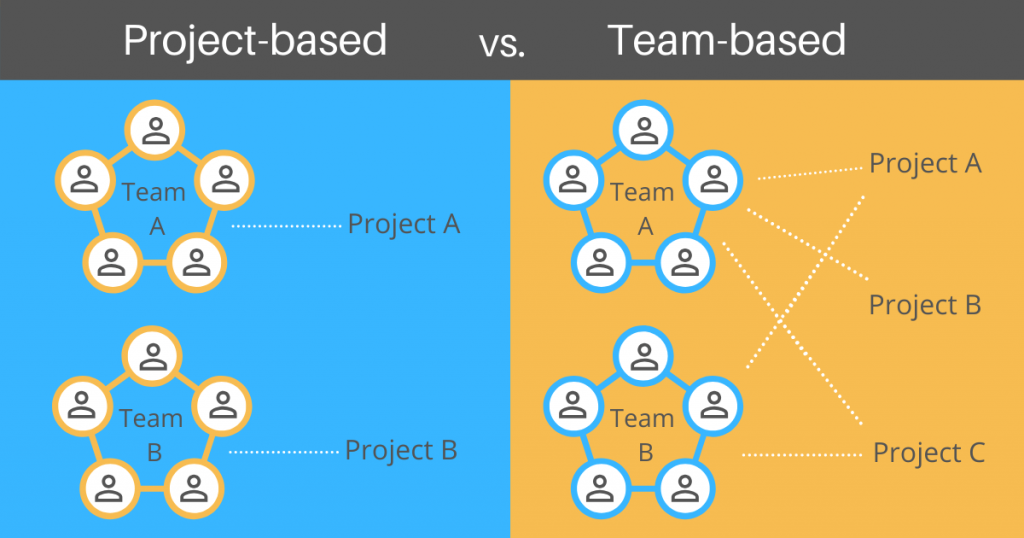Picking the right organizational model for outsourcing software development projects has one of the biggest impacts on the chances of a project’s success. In this best practices guide, we’ll dive into the sometimes not-so-obvious differences between project-based and team-based structures. At the same time, we will provide tips and recommendations based on Spiral Scout’s 14-year-long experience and expertise in the industry.
Project-based Structure vs. Team-based Structure
Software development projects available for outsourcing are often tackled by members of dispersed teams — some local, some around the globe, some working for the organization developing the software in different rooms, others working for distributed firms, or even working on their own. When it comes to successfully managing distributed teams for these types of jobs, the success of the project often rests on the way a company organizes their teams, particularly when they choose to hire a dedicated development team.

If you are figuring out how to outsource software projects for your business, look first at this essential guide to common organizational models. We are breaking down the pros and cons of each model and doling out expert tips and best practices based on what we have learned as a software development company over the last ten years.
What is a Project-Based Organizational Structure?
In a project based organizational structure, a dedicated team is assigned to tackle a single project from beginning to end. The team may consist of software developers, designers, business analysts, project managers, and software testers — in essence, people with all of the skills required to bring the project to fruition.
A project-based organizational structure is best for companies in flux, as it allows managers to use an outsourced development team and distribute employees on teams as needed to meet specific areas of expertise. However, effective outsourcing with project-based models requires clear communication and coordination to avoid duplication of tasks in the development process. Additionally, sharing knowledge and resources is crucial for delivering projects on time and within budget.
Advantages of project-based organizational structure
There are some advantages to this model:
- Clear communication. One project manager is assigned to the team and bears responsibility for communicating with the team and the client. Clear and cohesive communication in an outsourcing model can help to improve productivity and efficiency and remove roadblocks faster.
- Varied skill sets. These teams are cross-functional, bringing together people with different skills that can be brought to bear for successful project completion.
- Diversity of thought. Conversations between these team members can help identify new opportunities, innovations, and best practices.
- Single focus. When team members can all focus on one deliverable, particularly in a dedicated team model, they can be more productive and less distracted. Not being pulled in several directions at once can help to expedite the completion of their assigned duties — and the project overall.
But, there are some drawbacks of the outsourcing model can affect the overall development process:
- Tunnel vision. Concentrating on a single, narrow project may lead to tunnel vision with those involved in the project failing to see, or understand, the bigger picture.
- Management responsibility. The project manager’s skills and ability to successfully lead the team are crucial to success. Poor management can create the risk of team members diverting their attention to less important side projects.
- Replacing team members. The need to replace team members may be more challenging; it’s easier to replace team members based purely on skill sets than their participation in and knowledge of a single project.
This team dynamic may not be the best choice in all situations related to software project outsourcing. Fortunately, there is another option — the team-based organizational model.
Challenges of project-based structure
- Resource Allocation Bottlenecks: In project-based structures, one of the common challenges is resource allocation. Since teams are often organized around specific projects, there can be competition for limited resources such as the best developers, designers, or project managers for the task. This can lead to bottlenecks and delays in project execution as teams wait for key resources to become available.
- Lack of Cross-Functional Collaboration: Project-based structures can sometimes lead to siloed teams focused solely on their individual projects. This lack of cross-functional collaboration can result in missed opportunities for knowledge sharing and innovation, as teams may not be aware of what others are working on or may not have the opportunity to collaborate on broader initiatives.
- Ownership and Accountability Challenges: While project-based structures offer clear project ownership, this can also lead to challenges in terms of accountability. If a project encounters difficulties or delays, it may be challenging to pinpoint responsibility, leading to potential project setbacks.
- Project Delays: Due to the dynamic nature of tech projects, delays can be common in project-based structures, which may be mitigated by hiring a dedicated development team. Unforeseen technical challenges, scope changes, or resource shortages can impact project timelines, potentially affecting other projects in the pipeline, especially in nearshore software development scenarios.
When Is a Project-Based Organizational Structure Best For Your Project?
Project-based outsourcing finds its sweet spot in handling uncomplicated, straightforward ventures that are unlikely to undergo significant alterations. Here, the outsourcing team takes the reins and shepherds the projects to completion independently, with minimal need for your ongoing guidance or involvement, which is a hallmark of remote software development. A project-based organizational structure is well-suited for specific types of projects and scenarios. Here’s when opting for a project-based structure is the best choice for your project:
- Short-Term and Well-Defined Projects: Project-based structures excel when you have short-term projects with well-defined objectives, scope, and timelines. These projects benefit from the focused approach that project teams can provide, ensuring efficient execution.
- Clear Project Ownership: When you need clear project ownership and accountability, a project-based structure is ideal. Each project has a dedicated project manager or leader responsible for its success, making it easier to track progress and outcomes.
- Resource Efficiency: Projects with resource constraints can benefit from a project-based structure. Resources, including skilled professionals, are allocated specifically to the project, reducing resource fragmentation and optimizing utilization in the software development outsourcing model.
- Specialized Expertise: If your project requires specialized expertise or skills that aren’t readily available within the organization, a project-based approach allows you to assemble a team with the exact skills required for the task at hand. This is common in IT projects that require niche skills like cybersecurity or AI development.
- Rapid Adaptation to Market Changes: In industries where market conditions change rapidly, project-based structures enable organizations to quickly assemble teams to address emerging opportunities or challenges. This agility is crucial for staying competitive.
- Innovation and Experimentation: Projects that involve innovation, experimentation, or the development of proof-of-concept solutions are well-suited for project-based structures. They provide the autonomy and focus needed for innovative thinking within a dedicated team model.
- Client-Centric Projects: When your project is client-centric, meaning it directly serves external clients or customers, a project-based approach allows you to tailor the team and resources to meet client-specific needs. This is common in consulting, software development, and service industries.
- Diverse Project Portfolio: Different projects may require different skill sets, and assembling project teams accordingly ensures efficient execution across the entire portfolio.
- Fast Project Start-Up: Project-based structures are efficient for starting new projects quickly. You can assemble a project team, define objectives, and initiate work without the need for significant organizational restructuring.
- Clear Project Phases: Projects with distinct phases, such as initiation, planning, execution, monitoring, and closure, align well with project-based structures. Teams can focus on each phase sequentially, ensuring a structured approach to project management.
- Specific Project Goals: Projects with specific, isolated goals that don’t require ongoing collaboration or integration with other ongoing projects are ideal for a project-based approach. This ensures that teams can work efficiently toward achieving those goals.
- Cost Control: For projects with tight budget constraints, project-based structures offer better cost control. You can allocate resources and budget specifically to the project without the risk of budget overruns due to resource allocation complexities.
What is a Team-Based Organizational Structure?
In contrast, a team-based organizational structure is best for companies that already have teams working on projects. This structure focuses on encouraging teamwork, problem-solving, and employee empowerment. It is also highly adaptable to changing company dynamics and allows for better and faster communication between departments to avoid redundancy.
With a team-based organizational model, a distributed or remote team is asked to contribute to two or more projects at a time. For example, you might hire a distributed team that delivers both web application and mobile app development for your company.
Advantages of team-based organizational structure
The benefits of a team-based model include:
- Flexibility. The ability to be agile and flexible allows a team to switch from one task to another across multiple projects. In this scenario, there is rarely downtime; for instance, if one project is on hold while waiting for client feedback or input, the team can pivot to work on another.
- Skills applied more broadly. Team members aren’t limited to a single project that may not utilize all of their talents. In a team-based model, team members have the opportunity to leverage their skillsets across multiple projects and share those skills and knowledge easily with other members.
- Deeper understanding of business. The more experience team members have in working with a specific company or client, the more deeply they’ll come to understand the company’s overall business objectives and company products.
Challenges of a project-based structure
But, of course, there are some potential downfalls here as well in the context of software outsourcing. These include:
- Communication hurdles. Communication can pose a challenge when various teams and departments are working on the same project from different locations and time zones. Communication in the team-based model looks more like a multi-directional web than a singular two-way channel.
- Impacted output. Lack of team cohesiveness surrounding a project may also lead to reduced productivity and efficiency in product development. For instance, if communication breaks down between team members working together on multiple projects, all projects are likely to suffer.
- Conflicts for time and attention. When working on more than one project at a time, team members must make choices between projects, allocating their time as best they can. This may prove challenging at times, though, and output can be impacted.
Despite the pros and cons of both the project- and team-based organizational models, each might be the best option in certain situations.
- Knowledge Silos: In team-based structures, where teams are organized around functions or expertise (e.g., development, design, testing), there is a risk of knowledge silos. Team members may become highly specialized in their areas, but this specialization can limit their exposure to broader organizational knowledge and goals.
- Project Ownership and Accountability: Team-based structures may sometimes lack clear project ownership. When multiple teams collaborate on a project, it can be challenging to determine who is ultimately responsible for its success or failure. This can result in accountability issues.
- Communication Overhead: Teams often need to coordinate and communicate effectively to ensure the success of cross-functional projects. Managing communication overhead, especially in large organizations with multiple teams, can be a challenge. Miscommunication or lack of alignment can lead to project delays.
- Resistance to Change: Transitioning to a team-based structure can face resistance from employees accustomed to project-based structures. It may require a cultural shift and changes in the way teams collaborate and share knowledge, which can be met with resistance or reluctance.
- Risk of Resource Fragmentation: There’s a risk of resource fragmentation, where specific skills or expertise are dispersed across multiple teams. This fragmentation can make it challenging to assemble specialized teams for specific software development services projects.
When Is a Team-Based Organizational Structure Best For Your Project?
A team-based organizational structure is an ideal choice for your organization if your teams are already working on projects and you want to support a custom approach for your manager. This structure allows for greater adaptability and integration of an outsourced development team into the company’s hierarchical structure, resulting in improved quality and productivity without sacrificing flexibility and accountability. When determining when to outsource software development, a team-based approach can help build software development teams that positively impact company culture.
Let’s explore when opting for a team-based structure makes the most sense:
- Complex, Cross-Functional Projects: Team-based structures shine when your project is complex and requires collaboration among individuals with diverse skill sets. If the project involves multiple technical disciplines, such as software development, design, software testing, and data analysis, a team-based approach ensures that experts from each area work closely together, facilitating seamless coordination.
- Long-Term Initiatives: When you’re embarking on long-term projects that span months or even years, a team-based structure provides stability and cohesion, as team members work together over extended periods, developing a deep understanding of the project’s goals and challenges.
- Innovation and Problem Solving: Team-based structures encourage innovation and creative problem-solving. Teams bring together individuals with different perspectives and expertise, fostering brainstorming and the generation of innovative solutions. This can be particularly advantageous for projects that require out-of-the-box thinking or cutting-edge technology.
- Continuous Improvement and Learning: If your project involves ongoing learning and adaptation, a team-based structure is well-suited, particularly when leveraging the global talent pool of software engineers. Teams can continuously learn from each other’s experiences, adapt to changing circumstances, and apply collective knowledge to improve processes and outcomes.
- High Collaboration Requirements: Projects that demand high levels of collaboration, knowledge sharing, and iterative development benefit from team-based structures. This is especially true in agile software development methodologies, where cross-functional teams work closely together to deliver incremental improvements. According to PWC, agile methodologies, such as Scrum, Kanban, or Extreme Programming (EX), have a 28% higher success rate than other methodologies in software development outsourcing. These methodologies offer flexibility, continuous improvement, agility, and efficiency within software development teams, making them ideal for complex projects.
- Scalability and Growth: Team-based structures can be scalable, making them suitable for organizations planning significant growth. As the organization expands, additional teams can be created to accommodate new projects or initiatives, ensuring that the collaborative spirit remains intact.
- Knowledge-Intensive Projects: Projects that require in-depth subject matter expertise benefit from team-based structures. Teams can include specialists with deep knowledge in specific domains, ensuring that the project benefits from their expertise.
- Compliance and Regulatory Requirements: In industries where compliance and regulatory adherence are critical, team-based structures provide the advantage of consistent processes and documentation. Teams can work together to ensure that projects meet all necessary regulatory standards and quality assurance QA requirements.
- Support and Maintenance: For projects that involve ongoing support, maintenance, and upgrades, team-based structures are well-suited for delivering custom software solutions. Teams can take ownership of systems or products, ensuring their long-term stability and optimization.

Get The Mastering Product Discovery Checklist
Which Organizational Model is Right for Your Project?
Depending on the needs of your project(s), the software development organizational structure you implement with an outsourced software development team may vary.
Project-based models are excellent choices for:
- One-off tasks with flexible deadlines that aren’t closely linked with another project
- Projects that require multiple roles (i.e., project manager, designer, tester, etc.)
- Early-stage projects that require end-to-end engagement (from product discovery and requirements gathering to designing, coding, testing, deploying, and maintaining).
Team-based models are smart choices for:
- IT staff augmentation — for instance, bulking up your development resources to pitch in with multiple projects. Software development staff augmentation can be a perfect solution when your project requires more specialized knowledge, experienced resources, or even rare technology your current team does not possess.
- Ongoing and related projects where you have an in-house team can benefit from software outsourcing strategies
- Projects that already have requirements and discovery completed
Project- and team-based organizational models offer businesses two different approaches for tackling software projects. Each model has its own unique advantages and potential disadvantages, and each has specific benefits for certain types of projects.
Remember that there’s no one-size-fits-all solution. Your decision should be driven by your project’s requirements and your organization’s strategic objectives. One thing is certain, though: outsourced development team is growing and offering great opportunities for businesses around the globe to gain access to the specialized aptitudes and expertise they need to gain a competitive advantage.
If you find yourself in need of guidance or support, Spiral Scout can offer you the right choice. Our expertise in IT staff augmentation services ensures that you have access to the talent and structure that best aligns with your project’s goals, helping you navigate the tech-driven paradigm shift with confidence and success.
In the end, your project’s success hinges on selecting the organizational structure that empowers your team to excel, innovate, and deliver outstanding results. Choose wisely, and you’ll be well on your way to tech excellence in the ever-evolving landscape of technology.




